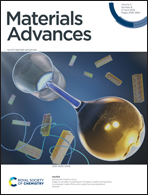A new method of synthesis of Sb2Se3/rGO as a high-rate and low-temperature anode for sodium–ion batteries†
Abstract
Sodium–ion batteries (SIBs) are expected to replace lithium–ion batteries with low cost and high safety to become a new generation of energy storage equipment. Here, a novel precipitation transformation method is used to synthesize Sb2Se3 wrapped by reduced graphene oxide (rGO) as an anode for SIBs. These Sb2Se3 nanoparticles with a large surface area and multiple active sites can accelerate sodium ion diffusion and storage, resulting in high capacity and excellent rate performance. At the same time, rGO can alleviate the particle agglomeration of Sb2Se3 caused by volume expansion and increase the conductivity of the compound to improve charge transport. This synthesis method enables nanoscale and tight integration with rGO, synchronously satisfying the fast transport of ions and electrons, which provides conditions for the development of low-temperature performance. More importantly, Sb2Se3/rGO exhibits a capacity of 260 mA h g−1 at a current density of 20 A g−1 at room temperature. Even at −15 °C, the capacity retention remains at 38% at a current density of 2 A g−1. Therefore, this precipitation transformation method can provide new ideas for synthesizing other compounds.



 Please wait while we load your content...
Please wait while we load your content...